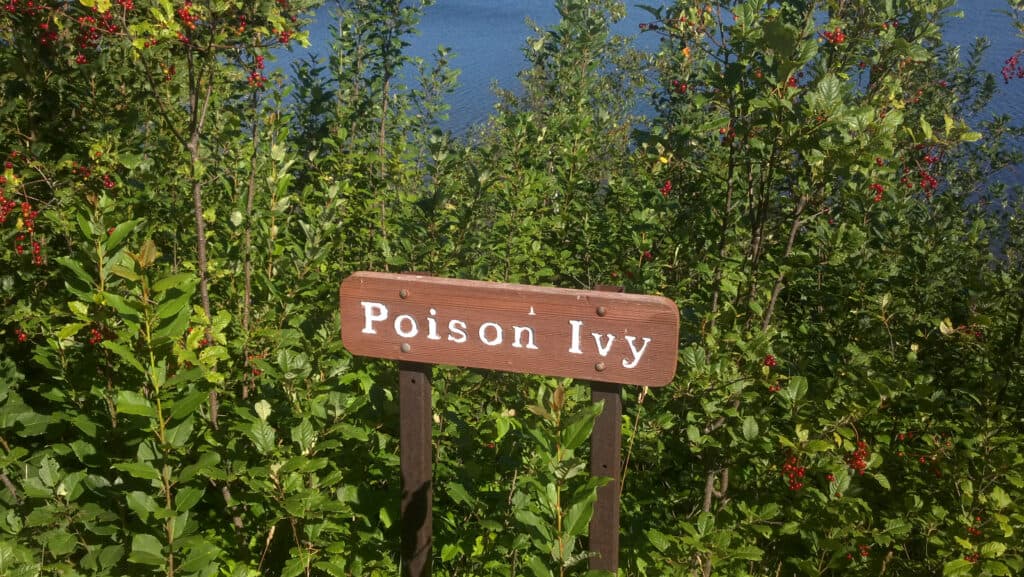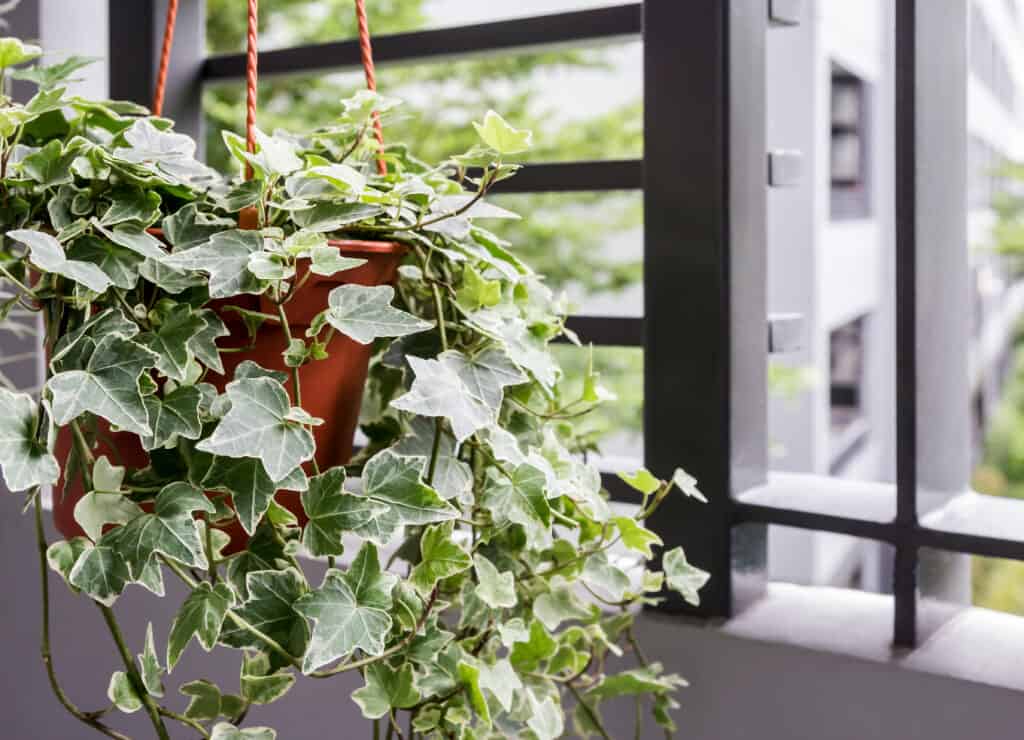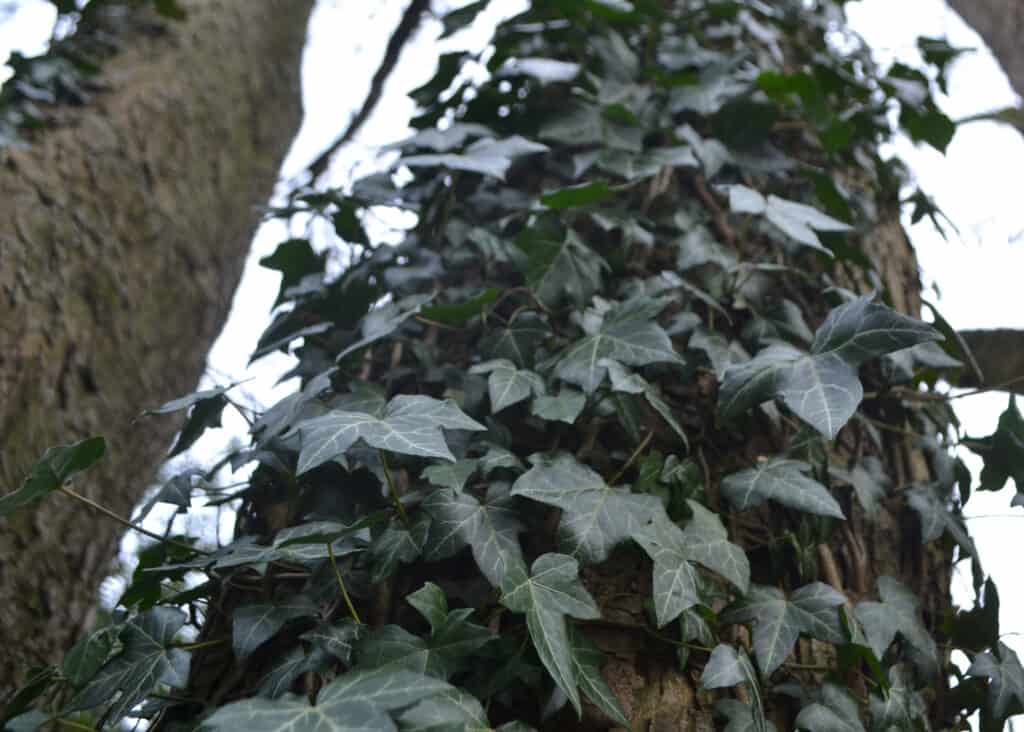Ivy is a well-known climber with green leafy foliage and tiny flowers that pollinators love. It grows in a huge range of conditions and it’s virtually bomb-proof, but not all ivies are safe around people and pets. Let’s take a look at poison ivy vs English ivy and figure out how to identify the one that causes discomfort.
| Name | Poison Ivy Toxicodendron radicans | English Ivy Hedera Helix |
| Origins | North America, Asia | Majority of Europe |
| Foliage | Three-lobed, pale green, waxy | Three to five-lobed, dark green, shiny |
| Flowers | Tiny and green | Tiny and yellowish-green |
| Berries | Small and white | Tiny, black-purple |
| Toxicity | Toxic to humans | Toxic for pets, can irritate humans |
Is English Ivy the Same as Poison Ivy?
No, English ivy and poison ivy are not the same plants, and it’s pretty easy to tell on-screen which one is toxic! It’s poison ivy of course and that’s easy to see now, but when you’re out and about it’s not so simple.
What Is Poison Ivy?
Poison ivy is a plant in the Toxicodendron genus. There are three generally accepted species.
- Toxicodendron radicans. The eastern poison ivy. It’s a climbing vine native to Asia and eastern North America.
- Toxicodendron rydbergiis. The western poison ivy. It’s a shrub native to Canada, British Columbia, and North America except in the south-eastern states.
- Toxicodendron orientale. A climbing shrub that’s native to South Korea and across to Japan.
The most common poison ivy in the States is the Toxicodendron radicans species. It’s common in forests where it uses its hairy roots to climb vertical surfaces up to 12 feet. It also climbs telegraph poles, and fences in urban areas, and where there are no vertical surfaces it forms a bush one to two feet tall. It’s really important to identify poison ivy and save yourself a lot of pain.
Poison ivy is well known for causing a painful and itchy skin rash. The highly irritating rash is created by a chemical in poison ivy’s sap called urushiol.
All the poison ivy species cause this skin reaction. It can be particularly bad if the leaves are used in place of toilet roll on a hike because blisters arise within minutes and they can get infected. As experienced hikers say “Look before you wipe”!

Poison ivy is well known for causing a painful and itchy skin rash. The highly irritating rash is created by a chemical in poison ivy’s sap called urushiol.
©Tim R7/Shutterstock.com
What is English Ivy?
English Ivy (Hedera helix) is a plant in the Hedera genus of the Araliaceae family. It’s also called common ivy, and European ivy,
It’s a familiar climbing vine that aggressively climbs fences, walls, trees, and houses with its aerial roots that effectively anchor the vine into tiny spaces with its own special glue! It can grow to 100 feet (30 meters) vertically or across the ground.
It is extremely easy to propagate because stems that drape on the ground root themselves in the poorest soils and because birds love berries they also spread their seeds far and wide.
English Ivy isn’t toxic like poison ivy and it’s used in ornamental gardens to cover ugly buildings or dead trees, or simply hanging from a basket. It’s one of the toughest plants around.

English ivy is a familiar climbing vine that aggressively climbs fences, walls, trees, and houses.
©ArtBackground/Shutterstock.com
Which Ivy Makes You Itch?
Both English ivy and poison ivy can make you itch and cause allergic reactions. If you’re gardening it’s always a good idea to wear gloves. Although English ivy can cause contact dermatitis it’s poison ivy that can do real damage.
The urushiol chemical in its sticky almost colorless sap is strong enough to cause swelling, redness, itching, cracks, and blisters. You don’t even have to touch the plant because its sap can be carried on pet fur or transferred onto clothing and it’s still enough to cause a reaction.
Fortunately, poison ivy is a lot less common than English ivy because the American Skin Association estimates 85% of Americans are allergic to it, 50 million people are affected each year, and it takes at least two weeks to heal up.
Poison Ivy vs English Ivy: Leaves
English ivy and poison ivy leaves are very different and it’s easy to tell them apart.
Poison ivy has light to mid-green compound leaves made of three leaflets with pointed tips. The stalk leading to the center leaflet is much longer, and each leaf has straight lines running from its center stalk to the outer edge. Poison ivy has a long and straggly vine, whereas western poison ivy grows in bush form.
English ivy has dark green leaves that alternate on either side of a long woody stem. Its leaves are around two to four inches long and each leaf has three to five lobes. English ivy leaves are shiny with wavy veining and its stems are woody and hairy.
One of the main differences between poison ivy vs English ivy is that poison ivy is deciduous. This means it will lose its leaves during winter and regrow them the following spring. In contrast, English ivy is evergreen.
If you’re trying to tell the difference between the two using foliage just remember this old saying “Leaves of three, let it be”.

English ivy has dark green leaves that alternate on either side of a long woody stem. One difference between it and poison ivy is it can grow in the winter
©Jenn Lodge/Shutterstock.com
Poison Ivy vs English Ivy: Flowers
English ivy has late summer to late autumn flowers. They are small, yellow-green, and bloom in clusters. They’re nectar-rich and loved by pollinators who struggle to find enough sustenance in late autumn. English ivy flowers mature into purple-black and sometimes orange berries in late winter. Its berries feed hungry birds, so if you have fruiting English ivy in your garden leave it for our feathered friends.
Poison ivy has tiny inconspicuous green flowers with five petals, that hang in loose clusters and mature to small hard white berries. Surprisingly, pollinators and birds are immune to poison ivy. They will happily eat the nectar and berries!
Are Poison Ivy or English Ivy Invasive?
Both poison ivy and English ivy are invasive. English ivy is more common in wild spaces because it’s less toxic to people and its evergreen leaves are able to photosynthesis all year round. Although English ivy is pretty and hardy, it’s not ideal in the wild because it can cope with very low light levels in a forest and its monoculture nature smothers everything else. It outcompetes native plants which leads to fewer species.
Poison ivy is a native plant. It’s not listed as invasive, but it will take over a garden if it’s not well managed.
Can I Grow English Ivy in My Garden?
Yes, you can grow English ivy in your garden. It’s an excellent wildlife plant and so versatile it can cover unsightly buildings, grow in shade, and hide bare container edges all year round. It’s best to make sure English ivy doesn’t escape your garden because it can cause problems in the wild.
Is Ivy Safe for Pets to Chew?
No, it’s not safe to let pets chew ivy.
English ivy contains saponins and it’s toxic to dogs, cats, and horses. It can also cause anemia in rabbits. Symptoms of English ivy poisoning are vomiting, diarrhea, and excessive salivating.
You might be surprised to hear the ASPCA doesn’t list poison ivy as toxic to pets, but it’s never a good idea to let pets chew garden plants. Any poison ivy sap that sticks to your pet can end up on your skin and cause a painful rash.
It’s Easy to Tell the Difference
So, that’s poison ivy vs English ivy and we can see there are some very clear differences.
English ivy is evergreen with three to five lobed dark green shiny leaves on a woody vine. It has yellow-green flowers and tiny black berries. On the other hand, deciduous poison ivy has 3-lobed compound leaves that are pale green and waxy. It has green flowers, hard white berries, and grows as a vine or a bush.
Up Next:
The photo featured at the top of this post is © Tim Mainiero/Shutterstock.com
Sources
- , Available here: https://www.amnh.org/learn-teach/curriculum-collections/biodiversity-counts/plant-identification/tips-to-identify-poison-ivy
Thank you for reading! Have some feedback for us? Contact the AZ Animals editorial team.






